| The Garden—March 2008 | |
| March 26 & 28, 2008 | |
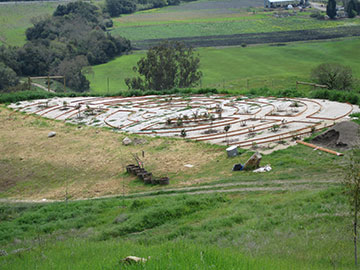 |
The bender-board is almost complete, but there are a lot of weeds in the garden. We will need to pull them soon. I am still trying to figure out what to put on the paths. If I plant grass and irrigate, weeds will grow like crazy, but hard surface such as gravel—is expensive. I am still trying to figure it out. I will be going to a rose conference in April and will talk to people there about what they have done. |
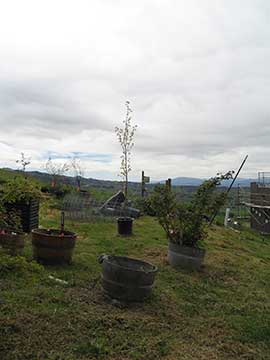 |
The trees in pots up by the barn are starting to leaf out. |
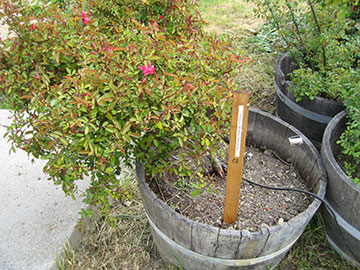 |
My chinensis mutabilis is looking very healthy, I am happy to say. This rose is a cutting from one at our current house which died quite suddenly. I was so happy to have had a healthy cutting of that rose, since it is such a great all-around bloomer. |
| March 21, 2008—the first day of Spring | |
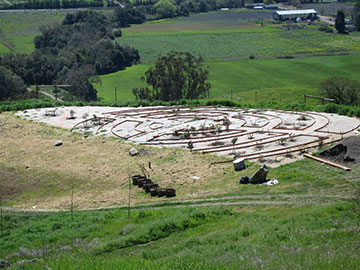 |
Today—the first day of Spring—was one of those heart-stoppingly gorgeous spring days, cool, clear and stunning. It warmed up respectably in the afternoon but stayed clear and calm. Kai got us another load of bender-board, so more beds in the rose garden are being defined. My assistant took off half a day for the holiday but has gotten a lot of weed-whacking done this week. |
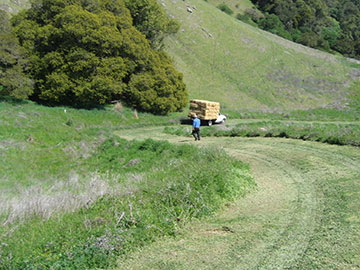 |
We got a load of straw, which we will use for mulch. This truckload is half the order of 100 bales. Luckily, the bales are only 50 lbs. or so when dry. We will get them very soggy and let them rot a little before we use them as mulch because the straw stays in place a little better that way. My assistant managed to get the road below the dam cleared earlier this week, which meant we could take the straw down below to store it. Before the weeds were cut, I would have been worried about the truck skidding or starting a fire. |
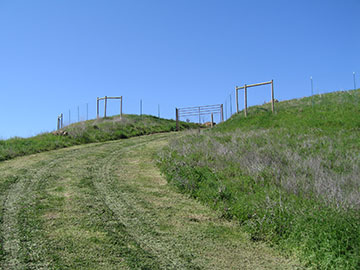 |
Here is a view up toward the lower gate from the road going across the front of the dam.
|
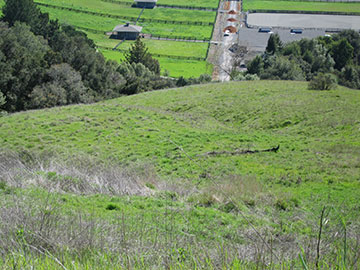 |
This is a view of Big Butt. You can’t tell so much from this picture—especially with the coyote bush growing out of the right cheek, but from a little higher, this formation looks like a big butt. (We also need to remove that remaining bit of silt fence.) |
| March 19, 2008 | |
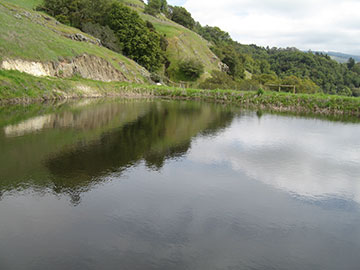 |
Once the fog cleared up, it turned into a nice day. I took these pictures of the reflection on the pond—this one from the dock. |
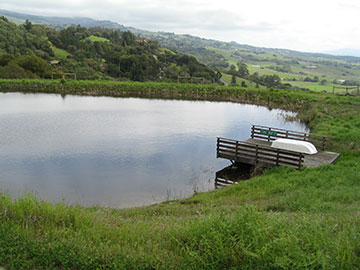 |
This shot was taken from the path around the pond. |
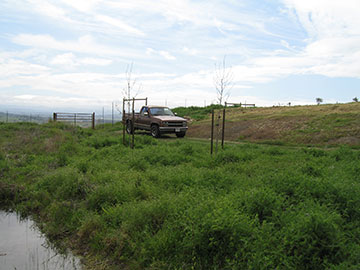 |
Here is my excellent truck parked in front of the lower gate. The sycamores are leafing out, but the leaves are still too fine to be seen yet in a distance shot. |
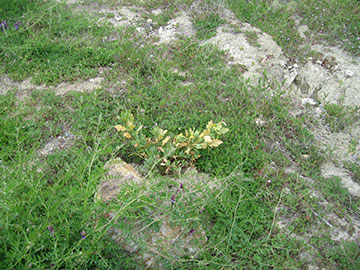 |
On the slope above the pond, we have planted some romneyas (Matilija Poppies). These plants form thickets of tall stalks with those wonderful flowers with white petals which look like they are made from crepe paper and yellow centers . It is my understanding that these plants need to be stressed to really flower well. This dirt where they are planted is not too fertile—nothing much will grow here—and although they will get some water, it won’t be too much. |
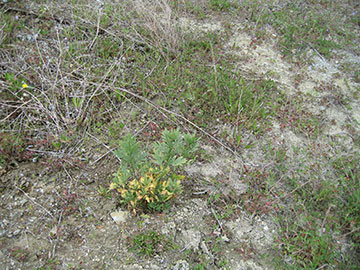 |
I have put these two shots in the site in hopes that later I will need them to compare with the huge, gorgeous plants they will grow into. We will see. |
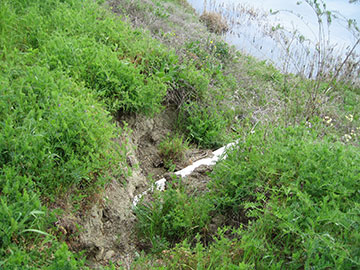 |
I walked out on the path to monitor the pipe from the gully into the pond. It does look a little more eroded, but not too much. |
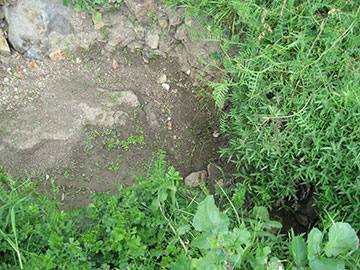 |
Here is the gully end, which as you can see, shows signs that it has been funtioning correctly as evidenced by the wet earth, wetter near the entrance to the pipe. I think the best solution in the future, is to dig this silt pond out deeper and put in a larger pipe to the pond above this one. If the water is running very hard, it could flow through the larger pipe if the silt pond is full of water instead of overflowing and running across the path. I won’t tackle this until next year, at which point we will also clean the dirt from the blow-out in 2006 out of the pond as well. |
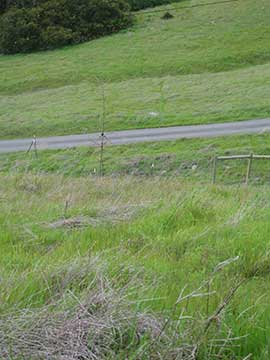 |
My Valley Oaks are leafing out! They all have leaves on them, and I am so happy about that. So far, I have not lost one tree. It was a good year for tree planting and you can never tell in advance whether that will be true, so I am very pleased. |
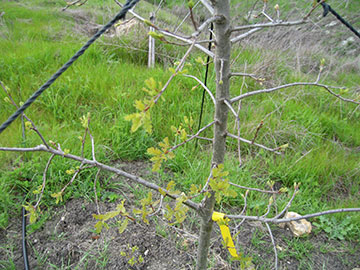 |
Here are the leaves on one of the Valley Oaks. I picked them out particularly from the various varieties of native oak because they are so beautiful. They turn into huge, gracefully spreading trees with lush, dark green foliage. They are not too well suited for our site, but hopefully, sheltered in the gully and irrigated, they will do ok. |
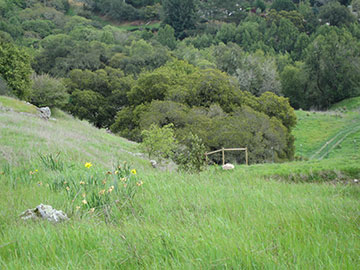 |
Here are the last two daffodils below the house. There are a few yellow ones mixed in with the white Early Cheers and they bloom a little later. Once these are finished, the dafs are done for the year. Hopefully, I will be planting herbs in this area before next spring, so there will be more than weeds there for them to come up through. |
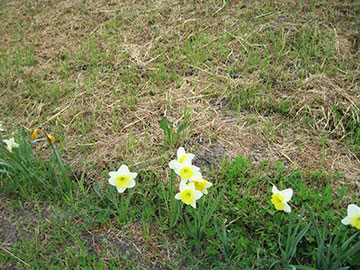 |
The dafs along the driveway continue to bloom, but they, too, are coming to an end. |
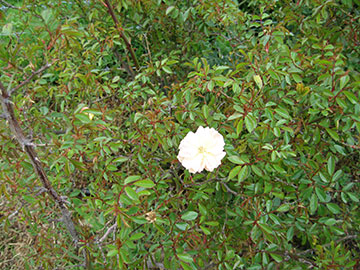 |
The first rose of this year is blooming on one of the Phyllis Bides on the fence. These roses never actually stop blooming, but we stripped them of leaves in January to force a dormancy, so this is technically the first rose, sort of. |
| March 14, 2008 | |
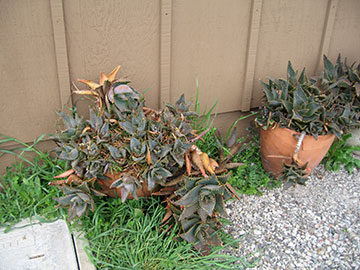 |
The aloes that I brought from our current house seem to be adapting and also opening out. If you look at the March 12th section, you will see a photo of an aloe with a flower and very reflexed leaves. I am pretty sure that is the same variety of plant as this one, which I brought up a long time ago. We will have to see if these plants reflex open as much as the one with the flower did. |
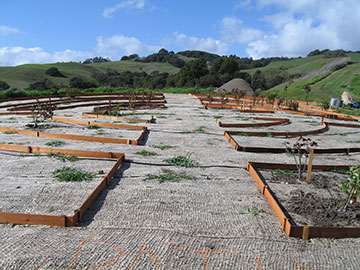 |
Looking north up the main path of the rose garden, you may notice it is not quite straight. This is on purpose to echo the curve of the yet uninstalled arbor. The two path ends—which aren’t installed yet—will curve more. |
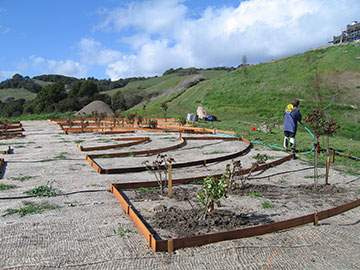 |
The bender-board is turning out to be a great interim solution to the edging problem. Eventually, I will probably get bricks, but until then, this looks great. My assistant is doing a terrific job on installation and just having the beds edged pulls the garden together. |
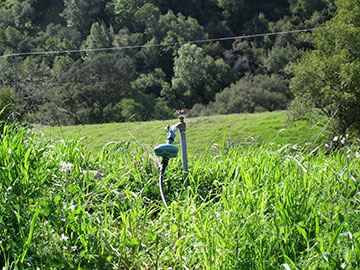 |
This tiny little battery-operated controller is irrigating the whole rose garden and seems to be doing a fine job. This controller, which is very moderately priced, was recommended at the hardware store, a recommendation that I have since seen repeated elsewhere. The company seems to have produced a very good product, of which we have quite a few. Eventually, I want to put in hard-wired controllers, but until we have an idea of the extent of the irrigation systems, the black tubing/battery controller will work fine. |
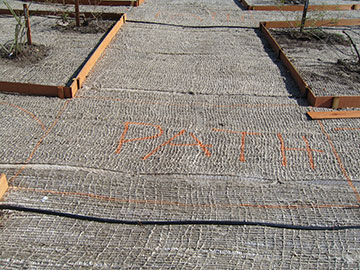 |
When we were laying out the garden, I had to print “PATH” in the paths so that we could keep track of what was path and what was bed. It’s easier now with the edges of the beds defined. |
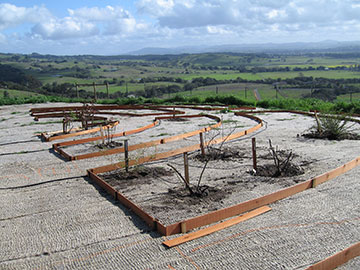 |
The roses all seem to be doing ok—some of them are even enthusiastic. I only have one still dormant, and I haven’t given up hope on it, even though it was not dug up properly. |
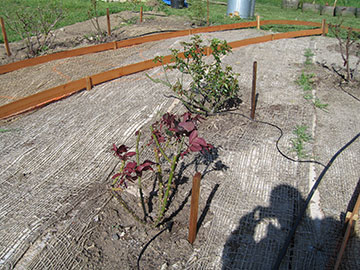 |
Here you can see a few of the roses fluffing out nicely—along with weeds coming up through our cardboard. The next step is mulching! |
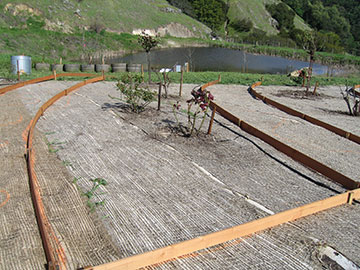 |
Here is a view toward the pond. The barrels in the distance are temporary homes for some of the climbers that will go on the arbor and some shrub roses that will be planted between the arbor and the pond. |
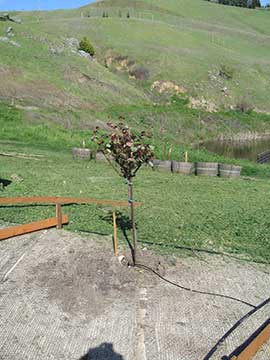 |
Here is one of the standard roses—sometimes called a rose tree. A standard is any plant which is not normally a tree shaped plant, that is made into a tree. You can do this with quite a few vines—such as wisteria—or train some shrubby plants this way. Rose standards are actually made with two grafts. A “trunk” is grafted onto root-stock. The trunk comes from some type of rose which particularly makes strong, thick, upright canes. Once that join is growing, the top is cut off the cane and several buds of the desired rose are grafted on the end. Rose standards serve several purposed in a garden, but a main one is to vary the height in a bed—basically raising one of the roses to a different level—to add visual interest. I hadn’t really thought about where I would put the standards when we moved the roses, but ended up putting them in an informal line out from the center ring—always according to color, of course. |
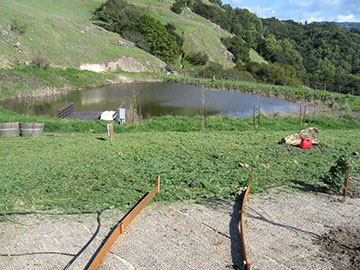 |
My assistant got all the weeds whacked down with the weed-whacker. Now we will be better able to scope out what we need to do before I call the company to install the arbor. |
| March 12, 2008 | |
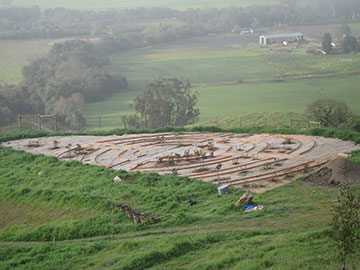 |
More bender-board was installed in the rose garden, but we ran out again. I am guessing that it will take as much as we have already installed to finish it. We are also going to cut the weeds down on the east side, so we can see what we are dealing with in order to the arbor. |
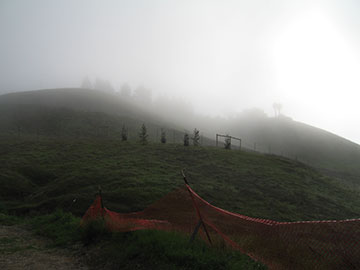 |
The ghostly grove . . . Here are our redwood trees backed by a glowing fog. I typical fashion, I did not even see the orange fence in the frame and so ruined a great photo. However, in my defense, it is awfully hard to see the preview screen on the camera in some lights. I often just point the camera and push the shutter button and hope for the best. |
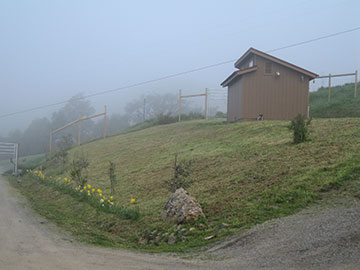 |
My assistant got a lot done over the weekend, including all the weed-whacking around the shed and down to the olive trees |
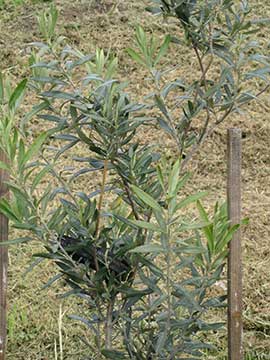 |
All the olives have fluffed out remarkably. You can see here all the new growth on this one. They are obviously thrilled to be out of their little pots and in the real ground. |
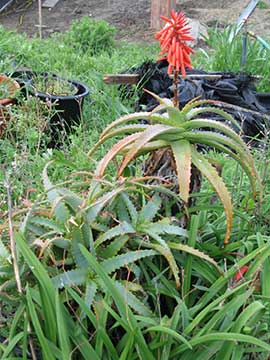 |
Here is a blooming aloe in a pot. I brought this plant up years ago and I think it is the same variety as the aloes in the pots in the next picture down, but looks much different. I guess that the shade makes the plant have short, closed leaves and the sun causes them to grow long and open. |
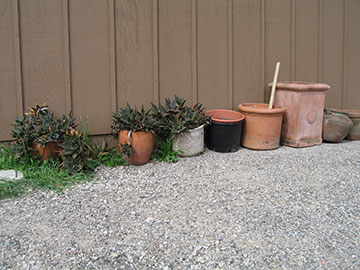 |
The row of empty pots left from the rose planting lines up against the barn. It actually looks kind of good—although after I took this picture, I removed the garbage from the one pot and the plastic pots altogether. |
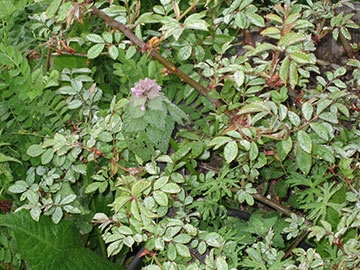 |
New country, new weeds. The weeds here are MUCH tougher and more virulent than than the city-dwelling weeds I am used to. I thought they were bad, but the ones here are much, much worse. This one is kind of pretty, though. I wonder what it is. |
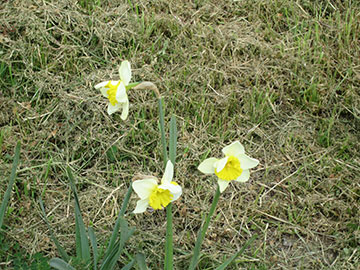 |
The next color of daffodils has opened up along the driveway. The big, yellow ones are slowly finishing up and these cheerful, fried-egg-like ones are opening up. There are also a few (thankfully few) anemic cream and peach ones, which I am not too keen on. |
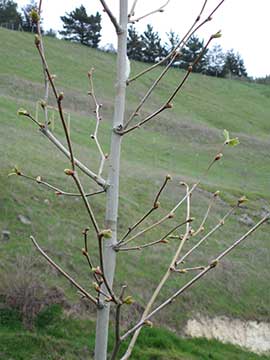 |
My sycamores are leafing out—all of them. So far, we have not lost one tree! I will let them get established this year and then start training them next year. |
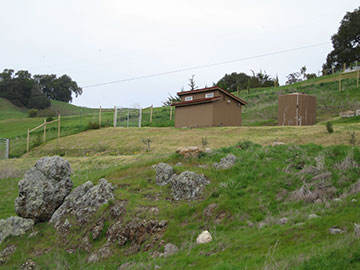 |
Here is one final view of the shed and water tank taken from the road below the house. I like this picture because of the great view of our rocks. I want to plant cacti and succulents above the rocks but don’t want to junk them up. I plan to look at the rocks a long time to get a feel for them, then, one of these days, I will just start planting. This is not a very deliberate way of gardening, but often, I get a great result by doing it this way. I find this way of designing much more grounded and less fraught than a planned garden like the rose garden. It seems to flow naturally from the heart and the connection with the earth rather than the intellect. Besides, with a garden, you can always move things if you don’t like how they look. |
| March 7, 2008 | |
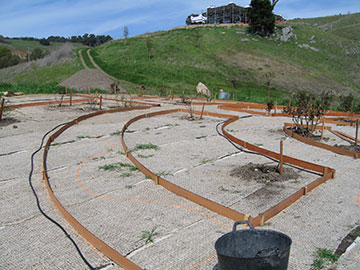 |
Here are quite a few shots of the rose garden. Putting in the bender-board was the right decision. We had to have something to define the edges of the beds because the paint on the cardboard won’t last for long. Here we are standing on the west side looking northeast toward the house—which looks much less obtrusive covered in black stucco paper instead of white Tyvek. |
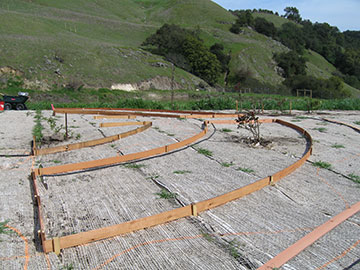 |
This shot is from the same path, looking southeast toward the pond. I want to put something on the path surfaces but I am not sure what. A hard surface, such as pavers or stone would be nice, but extremely expensive. Also, I received advice from an old hand in this area not to do hard surface or gravel paths because when gophers undermine a path, gravel falls into the hole and stone sinks and becomes a trip hazard. His advice was to do grass paths or some other groundcover. |
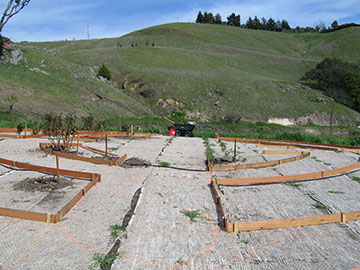 |
This is the main east-west path and we are looking through the central ring toward the pond. |
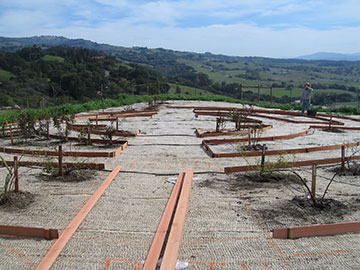 |
This is the north-south path looking south. My assistant has gotten more of the bender-board installed which makes the garden much more graphic and understandable. I hope it looks pretty when the roses start to bloom. |
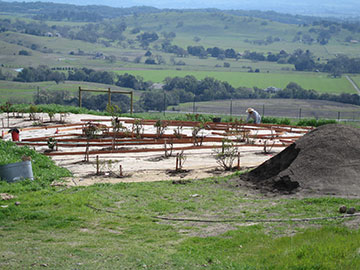 |
And we have GOT to move that dirt out of the white rose section. I had planned to use the dirt for the vegetable garden I will put in up by the house, but think that I may use it here on the paths instead and then plant seed in it. I have heard of a native yarrow, which can be mowed and used as ground cover and might plant that. If I do that though, it would have to be watered and have a sprinkler system set up for it separate from the roses—which would be a big pain. You can see from the above rambling that every decision in the garden has many consequences, all of which must be thoroughly contemplated before one takes action. |
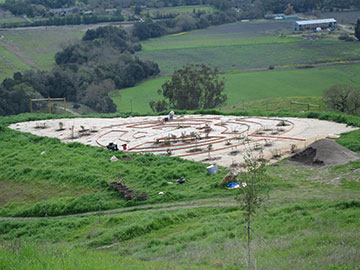 |
From up by the house, the garden is taking shape. When we first bought the property, I wanted to put in a labyrinth below where the rose garden is now. I had been interested in them since finding a book on garden labyrinths in the early ’80s. I don’t know if I will ever make one, but this rose garden looks a little like a labyrinth from above—so maybe this will be my version. |
| March 5, 2008 | |
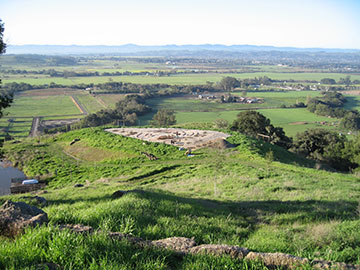 |
Here is the rose garden from directly in front of the house. Because web photos have such low resolution in order to load fast, you can’t really tell the pattern from this picture like you can in the original. |
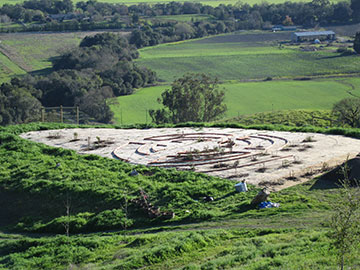 |
I took a close-up with the zoom lens and fortunately, you can see it in this shot. The bender-board has been partially installed (we ran out) and shows the pattern of the beds. Eventually, there will be a central ring of arbor in the middle for climbing roses.
|
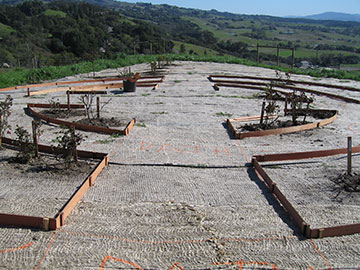 |
Here we are looking down the main path toward the southeast. |
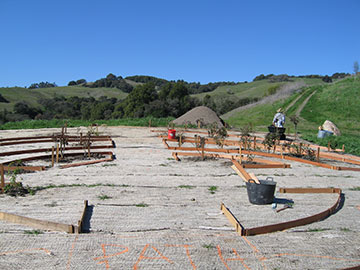 |
Looking back toward the northwest, this will be where the arbor circle will be constructed. |
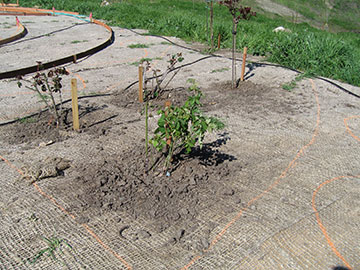 |
Most of the roses look remarkably good despite all the rough handling. I hope I don’t lose any, they are all old friends. |
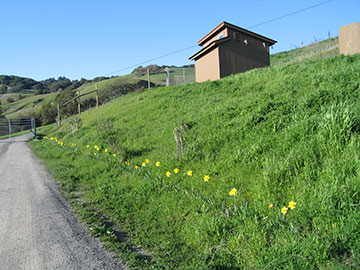 |
I can’t resist shots of the daffodils each week. There are a lot of daffodils along the road on the way up. The County has planted them on the banks of freeway entrances, where they have naturalized. On the road here, there is one farm gate which is totally unprepossessing, set in a bare field with a long gravel road stretching away from it. This time of year, it is totally transformed by thousands of daffodils ringed in a semicircle on either side of the gate. |
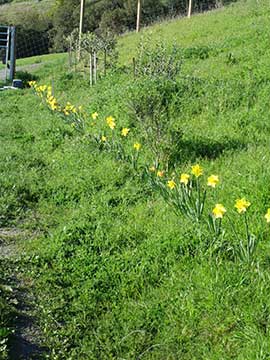 |
My soldiers are standing at attention, but the weeds are on the march. I hope my assistant and I will be able to budget some time for weed-whacking in the near future! |
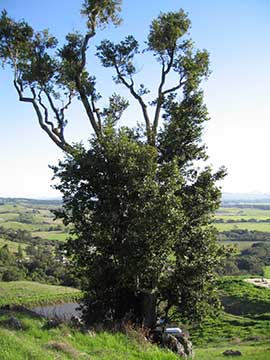 |
I haven’t taken a good picture of our bay tree for a long time. This stands below the dining room and a lot of people would have been tempted to remove it to improve the view—I know that was my first impulse when I saw it. But it is about 70' tall and quite magnificent to look at, growing out of, what seems as if it should be, a barren cliff. We will keep it. However, I do not feel the same way at all about the poison oak underneath it. We will get rid of that at the first opportunity. |
| Back to top | |

